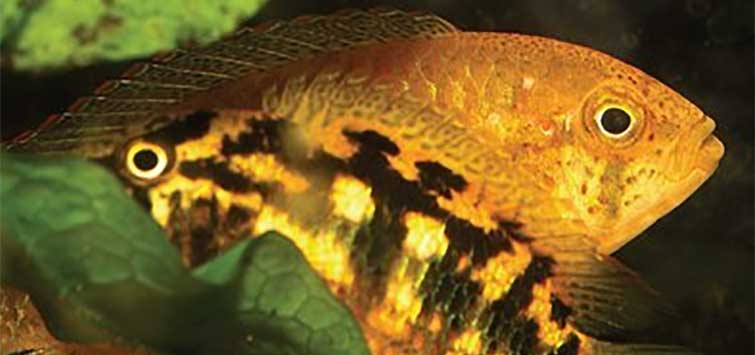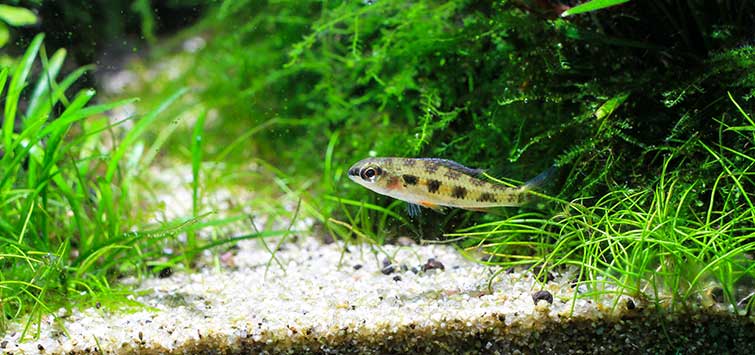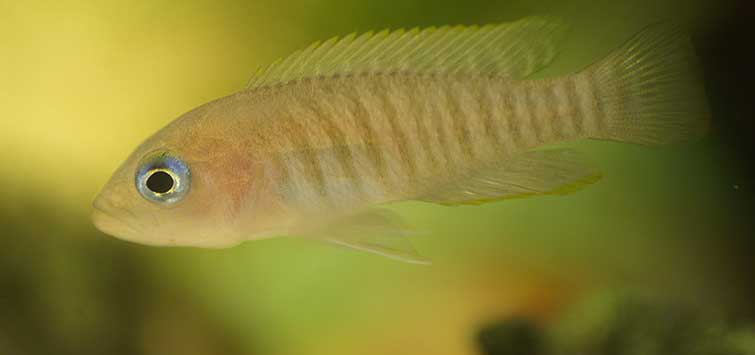Nannacara aurocephala: A Different Dwarf Cichlid
Author: Karel Zahradka
Nannacara aurocephala is an out-of-the-ordinary cichlid that doesn't require a tank the size of your living room.
Uncovering Apistogramma spp
Although I fully appreciate all the time and effort it takes to maintain large cichlids such as oscars and hornet tilapia in aquaria, I have to admit that I am not a fan of such fish. However, this does not mean that I cannot enjoy keeping and breeding a variety of cichlids in my aquaria, as a wealth of dwarf cichlids, from both the Old and New Worlds, is available within the aquarium hobby.
If we turn our eyes toward the fish treasure house that is South America, the most commonly seen dwarf cichlids from this extraordinary part of the world are the wonderful Apistogramma spp. Within this genus is a wealth of species, with males that show an amazing difference in coloration, yet with females that are so alike that telling one species from another can be an extremely daunting task. If we dig a little deeper, however, a number of other beautifully patterned dwarf cichlids, many of which share the same habitat of Apistogramma cichlids, can be found in the hobby.
Nannacara
Among these fish are members of the Nannacara genus. Amazingly, only Nannacara anomala,which has been represented in our tanks since 1930, has become established in the hobby. This fish is often called the golden dwarf cichlid.
So how can other members of the Nannacara genus be found within the hobby? This usually happens when the fish arrive as accidental imports into the holding tanks of aquatic wholesalers.
My Nannacara aurocephala arrived into my aquaria from a totally different source, however. Two years ago, my friend Ing. Vlado FÁbry, a killifish specialist with a good knowledge of other ichthyofauna, returned home from French Guiana with a varied collection of fish species. The opportunity to photograph these fish was not to be missed, so I grabbed a camera and hurried to Vlado’s fishroom.
Feasting my eyes upon wild-caught Rivulus xiphidius and various Characidium species was a pure delight, but something even more spectacular came into view—two pairs of young Nannacara aurocephala.
Vlado is always very generous, so I returned home with a pair of these. As space is the key to maintaining Nannacara, the fish were given the freedom of a 60-liter (15-gallon) tank. They were fed well on a diet of live daphnia, cyclops, whiteworms, and the much-relished tubifex worms. This also brought them into spawning condition, so, when the female put on the typical spawning dress for Nannacara, I put into the tank some halved flowerpots. Water parameters were 300 microSiemens, with a pH of 6.8.
Spawning
The Problem
When the first spawning occurred the female seemingly did everything right. Thankfully, she did not kill the male (as often happens with a pair of N. anomala when the tank size is too small) but kept him well away from her chosen flowerpot. The eggs were hidden inside this container. I was disappointed when I realized that the eggs had fungused.
The Fix
After this failure, I changed the water in the tank for water that more closely replicated the natural habitat of the fish—80 microSiemens conductivity, pH 6.8 (the parameters I normally use for spawning small characins).
Fish never cease to surprise me, so with the second spawning the pair placed their eggs not within the safety of the flowerpot but on the top side. This time I decided to intervene in a bid to save the eggs. I removed the flowerpot, with eggs still attached, to an aquarium containing soft water and with a fine airflow. I kept a close watch over the eggs and, every three hours, eliminated non-developing eggs with the help of a needle until only fertile ones remained. As a result of this experiment I was able obtain 10 fry and had great joy in bringing these up to adult size.
Results
About three weeks after their second spawning, the pair spawned again. To show me their versatility they spawned on a Microsorum leaf. As the female placed her eggs, laid in a line, the male waited next to her and then, in his own time, fertilized the eggs in a very determined manner. After a while the fish changed tactics, and as the female laid her eggs the male immediately fertilized them.
With egg laying over, the female vigorously guarded her clutch. The male is of no use to her now and is a threat to the precious eggs, so he is dispatched to a corner of the tank. He is often killed if the tank space is not large enough. Again, when signs of fungus began, I had to remove the eggs to a separate tank. Several fertile eggs developed fry, which hatched without any hitch, and were grown to adult size.
In the Community
At this point I abandoned the breeding program, as the pair seemed to be poor parents, and placed the pair into a 300-liter (80-gallon) tank that was home to about a hundred different small characins and Corydoras. Water in the tank is normally 300 microSiemens with a pH of around 7.0. After a week, I was surprised to find the female aurocephala guarding a number of eggs on the bottom glass in a corner of the tank. I left all alone and a few days later found the female in the opposite corner of the tank, no longer able to keep control over her group of growing fry.
Observing the Fry
Within the next two days the fry began to swim properly and were all over the place. The characins (predominantly cardinal tetras) planned their cichlid-fry hunting strategies only to be thwarted by a very agitated cichlid mother, adorned in black coloration, who made lightning-quick attacks in order to drive away the predatory characins! At this point I abandoned my hard nature toward these fry and, using a siphon tube, removed around 80 fry and placed these into a 10-liter (2½-gallon) tank.
Three overlooked youngsters were left in the care of their mother. She did a good job for a few days but found her task impossible, so the fry were lost. Two days after her final fry had gone, the female was spotted nervously swimming across the tank looking, in vain, for her lost youngsters.
Breeding Facts
This breeding adventure reminded me of two important facts: First, water chemistry can be important for the development of eggs. Get this wrong and eggs can fungus. However, if parents conscientiously care for their eggs and resulting fry we can, sometimes, get away with less-than-ideal water parameters. Likewise, water parameters seem less important when the parents have other fish to protect the eggs from, presumably because this causes them to attend the eggs more diligently. Early aquarium hobbyists knew this fact and would never breed little cichlids of the genus Apistogramma without the addition of several small guppies to the breeding tank.
I have thoroughly enjoyed sharing with you my experiences of breeding a very different dwarf cichlid. Don’t forget to watch out for such oddities next time you are in your local retail outlet.
See the full article on TFH Digital http://www.tfhdigital.com/tfh/201007/#pg79

.png?h=595&iar=0&w=2781&hash=5FD5E69473BCC22199FBFA2FB71B6033)



